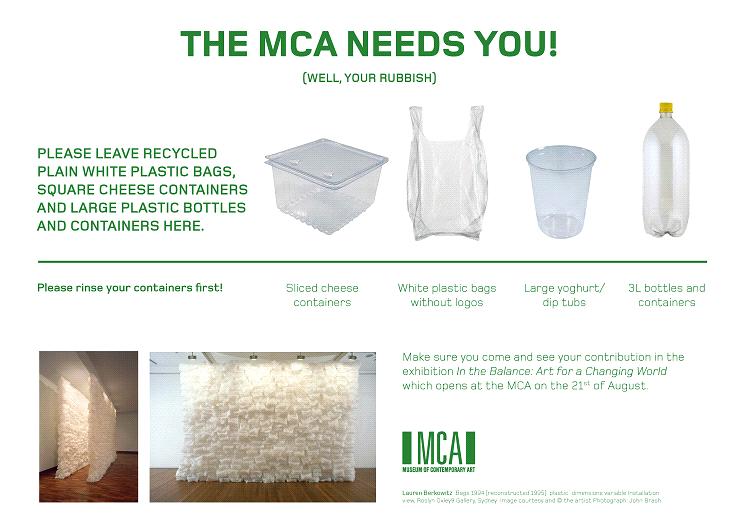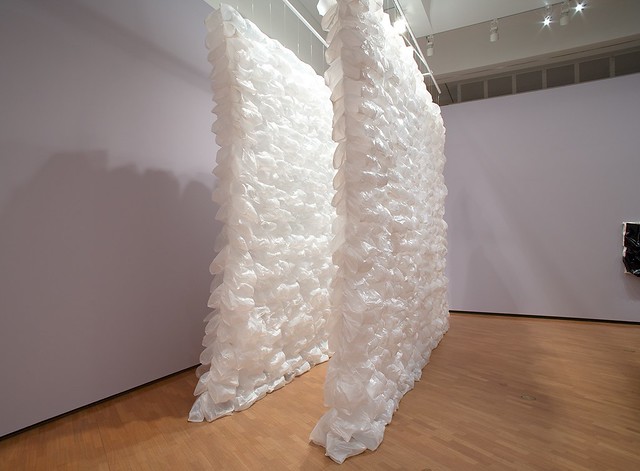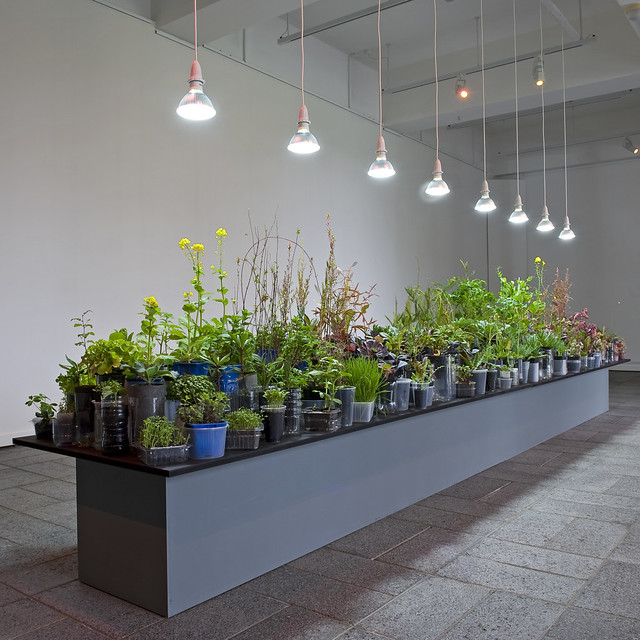We’re into the final month of our collection for two Lauren Berkowitz installations and we still need more!
We need:
-1500 white plastic bags
-50 sliced cheese containers
-80 large plastic bottles or containers – as big as you can find – 3L coke bottles, huge juice bottles and big Harris Farm yoghurt/dip pots!Please remember to keep bringing in items from home, and don’t throw away our milk bottles from the kitchen – just pop them in the box in the lunchroom.
Pushing forward that great aesthetic tradition in which garbage is transformed into art, the MCA (on behalf of artist Lauren Berkowitz) has issued the above callout.
Thus far, I believe that the request for plastic containers and bags has been directed mainly at the staff of the MCA itself, who are urged to bring in stuff from home as part of their ordinary routine of coming to work. This, I suppose, also taps into the folksy tradition of the workplace fundraising drive – common in schools and offices.
Here’s Lauren’s plastic bag piece as previously installed:
[Lauren Berkowitz, Bags, 1994, plastic, dimensions variable, Image courtesy and © the artist, photograph by Steve Farelly.]
…and here’s a former version of her work involving all the yoghurt pots etc:
[Lauren Berkowitz, Sustenance, 2010, medicinal and edible food plants, light globes, table, 70 x 480 x 60 cm, courtesy the artist]
Now, I don’t know how rapidly Lauren’s garbage collection process is coming along, but I figured I could kill two birds with one stone: by advertising here for more trash on Lauren’s behalf, and simultaneously reflecting on the use of rubbish for the production of art. (By the way, is there a less violent metaphor available for this double functionality than “kill two birds with one stone”?)
Incidentally, just today in the Sydney Morning Herald there was an article about Tracey Luff, an artist who uses scavenged corrugated cardboard to make her sculptures. (Here’s a link to her exhibition at NG Gallery.) Tracey says something rather interesting. It’s this:
“Recently, I think the economy isn’t that good. Some of the cardboard that I collect, I don’t get it for a while and I kind of worry I run out.”
What’s going on here?
First, a direct correlation between growth in the financial economy, and the production of industrial waste products. No great surprise there.
Second, the artist in her work diverts cardboard from the recycling stream, faithfully following the “waste heirarchy” dictum of re-use before re-cycle).
However, I want to go on a small hypothetical journey for a moment…
Assuming the artist’s work becomes ever more publically recognised and celebrated (eg through its publicity in the Sydney Morning Herald), there exists the possibility of an inversion of this relationship. In other words, the artworld’s demand for the waste product may begin to outstrip supply.
At this point, the artist is faced with a dilemma: work a heckuva lot harder, and travel much further afield to gather the raw materials to produce the art, or else use good old fashioned money to solve the problem, buying the cardboard from an industrial supplier.
Either of these options involves the investment of an increased amount of energy to produce the work. From this moment the “meaning” in the artwork — via its own production ethics — shifts radically .
There is, of course, another option: do something else. The artist could use the altered economic situation as a prompt to work with other materials and processes more consistent with the original ethic of waste re-use.
This dilemma is, I think, emblematic of what I was groping around with yesterday in my crude pondering over whether an artist’s practice can have “articulated policies and procedures”. In Tracey Luff’s case, the cardboard salvaging process connects thriftiness with environmental responsibility. As she says, this is something that goes way back to her childhood: “We didn’t have much, so … we don’t just chuck away – we recycle. I’m still doing the same thing.” Necessity produces a work ethic: that’s a policy of sorts, right?
So! Back to Lauren’s plastic harvesting project at the MCA. How does her callout operate in the lives of those who donate bottles and packaging?
For those of you who decide to donate your trash (in the name of art) here are some questions (in the name of this Audit!):
-or-
-and-
-or-
-and finally-
– – –
update: Flora, who works at the MCA and is co-ordinating the trash-cull, just wrote to me with the following info about Lauren’s quest:
It’s a massive collection of 3000 plastic bags, 800 plastic plant pots and 700 plastic containers. We’ve done internal collections in our office, and we’re doing a public call out next week – newspapers, blogs, facebooks, newsletters, anyone who will listen to me!
So far we’re half way there on the bags, and most of the way there on the bottles/containers, and have all the plant pots we need. We’re hopeful we’ll get everything!




Update! I got in touch with Lauren Berkowitz, who forwarded these answers to some of my questions:
Shopping bags and carrier bags made of plastic have been popularly replaced by paper bags in many establishments.
Now, the those bags have been further delimited to recycled ones.
Unlike plastic bags however, that cause health and environmental repercussions because of the toxins from the plastic when disposed of and recycled improperly, those bags including recycle bags pose no threat to us and the environment.
hah! The above is a spam comment, but I’ve let it through just this once.
Seems the spambots are cashing in on the green dollar too, eh!
related: the Plastiki boat made from 12500 plastic PET bottles…